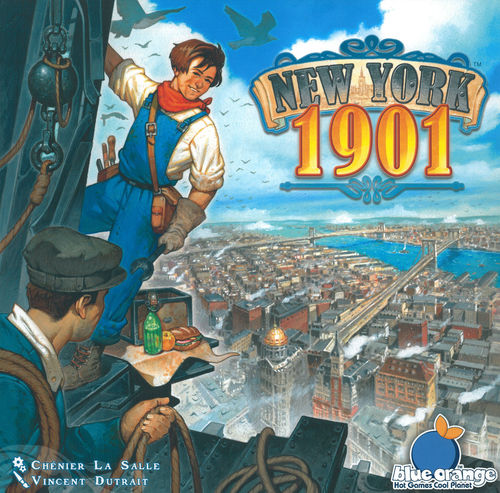Kahuna board game review
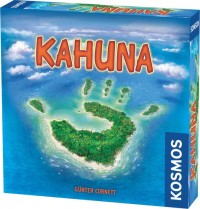
Let’s take a trip to a tropical island.
Better yet, let’s journey to many tropical islands.
Or better still; let’s vie for control over all those islands and be the big Kahuna!
That’s what you can do while playing the board game Kahuna by Kosmos.
In Kahuna, 2 players compete over control of 12 islands in the Pacific.
But control may not last.
During the game, control of the islands may swing from one player to the other.
Do you have what it takes to become and remain the big Kahuna?
We recommend you find out.
How to play Kahuna
Kahuna is played over a series of 3 rounds – with scoring taking place at the end of each round. The player controlling the most islands when those moments occur will score points. The player with the highest score after the third round wins the game.
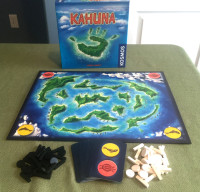
That’s all there is to it.
Of course, while the goal may be simple, achieving it may take some work.
Players start by choosing their color (white/black) and taking the 25 bridges and 10 Kahuna tokens of their color. Each player also starts with 3 Island cards in their hand. The rest of the island cards create a draw deck and 3 island cards are placed face-up next to it.
Then players take turns doing the following:
- Play Cards
- Control Islands
- Remove Opponent Bridges
- Draw an Island Card
Play Cards
On their turn, a player can play as many island cards as they wish (including 0). After playing a card, the player places one of their bridges on a connecting line from that island to a neighboring island. They then discard the card.
Control Islands
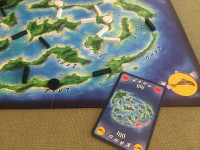
If more than half of the connecting lines from that island are covered by their bridges, then that player gains control of that island and places one of their Kahuna tokens on the island.
For example, if an island has 5 connection lines to other islands, a player would need to claim at least 3 of those connections with their bridges to claim control of the island.
When they gain control and place their Kahuna token on an island, they also get to remove any of their opponent’s bridges that are also connected to that island. And sometimes, removing a bridge may mean that the other player also loses control of another island. That’s because they may no longer have the majority of bridges to that other island.
Remove Opponent Bridges
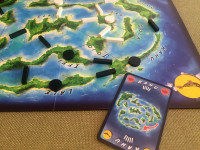
Another way to remove an opponent’s bridge is to play two cards that each show one of the islands that bridge is connected to. They can show the same island or both islands.
And if the player also has another card of one of those islands, they could then play it as well to place one of their own bridges in that place and totally swing the balance of the game.
Draw an Island Card
At the end of their turn, a player may draw 1 island card from either the draw deck or one of the face-up island cards (immediately replacing it with a card from the draw deck). They may also choose not to draw a card, but only if their opponent hadn’t abstained from drawing a card on their prior turn.
Players can’t hold more than 5 cards in their hand. If a player already had 5 cards in their hand (because they chose not to play any cards), they don’t draw another card.
End of Round Scoring
Once the draw deck is empty and the last of the 3 face-up cards are taken, the round ends. Each player counts the islands they control (have their Kahuna tokens). If it’s a tie, no one scores any points.
After the first round, the player with the most islands under their control scores 1 point. At the end of the second round, the player with the most scores 2 points.
After both of the first two rounds, the discarded island cards are shuffled and a new draw deck is created and 3 face-up cards are placed out again. The turn of the player who triggered the end of the round is over and play continues with the other player.
Play continues in the same manner until the end of the third round.
Final Scoring
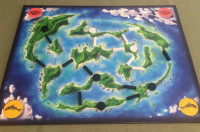
After the island cards are depleted for the third time, each player takes one more turn and then final scoring takes place.
This time, the player with the most islands under their control gets points equal to the difference between their islands and their opponent’s islands.
For example, if one player controls 6 islands and the other 4, the player with 6 under their control will gain 2 points (6-4).
That score is added to the points from the first two rounds and the player with the most total points wins the game.
Alternative Ending
There’s actually another way the game can end. If during the first or second scoring period one player no longer has any bridges on the game board, they automatically lose the game.
And that’s how you play Kahuna.
Can the whole family enjoy Kahuna?
As you can see, Kahuna is a simple game to explain and play – which makes it a great candidate for family play. And indeed it is a fun game for families.
But even though it’s simple to understand how to play, it will require some good thinking strategy in order to win. So in that sense, it’s good for players of the same aptitude to play against each other.
However, as that’s not always possible in a 2-player family game, the rules suggest a way to adjust the help the less experienced player. The rules suggest that the less experienced player place an agreed-upon number of bridges on the board at the start of the game.
That may be a good way to start when playing against your kids. But watch out, because they’re sure to start picking up on some of the strategies and before you know it, they’ll become the big Kahuna and you’ll be left out to sea.
Elements we enjoy
Even though we have 6 members of our family, it’s quite often that 2 of us will sit down to play a game together. So having a number of good 2-player games on our game shelves is a great benefit. And Kahuna fits great within that collection.
While the theme of Kahuna is playing for control of the islands, it feels a lot like an abstract strategy game with an island theme thrown on. But we don’t mind that at all.
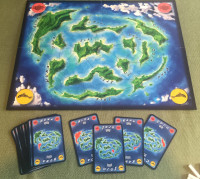
With 12 islands scattered around the game board, one thing we love are the orientation marks on both the board and the island cards. Each island card displays the name of the island, the island location highlighted in red, marks indicating the number of connection points to that island, as well as the orientation marks.
Orienting your hand of cards to match the orientation of the board makes finding the island location on the board a breeze.
But the thing we like the most about the game is the simple fight for control of islands. And the best is creating a chain reaction of control – either lost or won, or both. There’s not doubt that the most celebrated moves are those where you gain control of an island and in turn cause your opponent to lose control of one or two of theirs in the same move.
So fun!
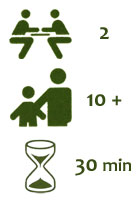 Timing it right and making the big shifts of control is at the heart of the game and where the fun lies.
Timing it right and making the big shifts of control is at the heart of the game and where the fun lies.
How does Kahuna score on our “Let’s Play Again” game meter?
Kahuna scores well on our “let’s play again” game meter. Because it’s a 2-player game, with head-to-head battles, it’s so natural to want a rematch right after losing a game. However, because it’s about a 30 minute game, it’s not a quick replay like some of the other 2-player games we enjoy.
That being said, Kahuna is still a game that joins the ranks of enjoyable 2-player games that will see frequent plays.
Thanks Thames and Kosmos for another fun family game!


